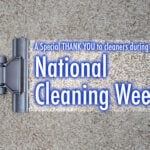16 Ways to Protect Your Company and Clients During a Pandemic
All commercial venues are concerned about protecting the health of building users and occupants during the COVID-19 pandemic. There is so much to learn about how the coronavirus spreads. In-house and contracted service professionals who are devoted to the safety of others are working hard to ensure that their staff are educated on the virus and how it spreads.
Below are some steps that can be taken to minimize the spread of SARS-CoV-2, the virus that causes COVID-19, within your facilities.
1. Ensure that the disinfectants used in your facility are proven to kill SARS-CoV-2. Log into the EPA’s website (epa.gov) and enter the product’s registration number on the label. Since all disinfectants are not the same, if the product is considered effective on coronavirus, the disinfectant will be found on List N.
2. Make sure you have the following items at the entry of your facility: a contact tracing form for all who enter, disposable gloves, masks, and hand sanitizer. I have seen companies go as far as facial digital readouts of a person’s body temperature. A digital thermometer is the most common and acceptable method.
3. Emphasize a greater focus on cleaning high-touch surfaces. Some are obvious, others are not so obvious. Obvious surfaces are doorknobs, light switches, counters, tabletops, desktops, railings, and elevator buttons. Spots that are easy to overlook include the backs and bottoms of chairs, vending/ATM machines, copy centers, push/pull bars on doors, latches on the front and back of bathroom stall doors, feminine hygiene disposal units, changing tables, and water cooler pulls or buttons. These are surfaces where COVID pathogens can collect quickly because of the amount of touches per hour, making them the most important areas in a facility to be serviced.
4. Maintain clear signage and communication reminding staffers to wash their hands, wear masks, and socially distance themselves. Supplies can be obtained from local vendors. Make sure these are in highly visible spots like restrooms, cafeteria/break areas, entryways, and main hallways. Sometimes a simple reminder is enough to produce compliance.
5. Maintain good airflow. Fresh air makes infection by the coronavirus much less likely. HVAC systems should be adjusted so that more fresh air is mixed in with recycled air. More efficient filters need to be placed within the heating and cooling system as well. Consult with a professional as not all systems can accept the best filters and the HVAC System requires the correct air flow to avoid sustaining damage. Most systems cannot tolerate greater than a MERV 10 filter. When weather permits and when/where possible, open doors and windows to allow fresh air to circulate throughout the facility.
6. Inspect and change HVAC filters as they are typically changed once or twice per year, but with the presence of COVID, they should be changed more frequently. I have been recommending intervals of every other month to every third month. This is to ensure proper air flow. The more effective the filter, the more easily loaded with soil it will become, restricting air flow.
7. Consider installing an ionizer in the HVAC system to aid in the removal of COVID-19 as well as other airborne viruses, bacteria, spores, mold, pollen, and harmful pathogens and substances that can damage the respiratory system.
8. An often-overlooked task is cleaning the carpets on a regular basis, as carpets and other soft coverings in a facility act as enormous filters, collecting all kinds of contaminants. As people walk across the carpet, they loosen these particles and reintroduce them into the air, creating additional health risks for those with upper respiratory issues.
9. Look for ways to limit the number of people using the facility at one time. Consider introducing flexible hours and staggered work shifts. Many counties and states have requirements based on what threat level a community is experiencing.
10. Install clear plastic or glass partitions around desks, especially around customer call areas. If using plexiglass, understand that most cleaning chemicals will damage these surfaces, causing them to scratch and fog permanently. There are specialized products for these types of surfaces.
11. Thanks to COVID, many of the modern office floor designs are now outdated and will contribute to the spread of the virus. Plastic and/or glass partitions along with more traditional fabric-covered wall partitions will be needed to better help enclose and isolate areas. This helps prevent airborne coronavirus particulates from spreading.
12. Pandemic-proof your restrooms. If viable for the space, the use of offset walls to reduce touch points is very effective. In addition, install no-touch systems with flushers (urinals, toilets, and sinks) and dispensers (paper towel, hand soap, hand sanitizer, and toilet seat covers). Remove high-velocity hand dryers as they spread droplets and aid in the spread of coronavirus and other diseases.
13. Where possible, install close-fitting toilet lids as this will reduce the addition of approximately 6,000 droplets into the air each time a toilet is flushed. This is known as the “toilet plume” or “toilet sneeze.” Various studies done on these droplets show that they can remain airborne for up to 8 hours and land on all surfaces. It has also been shown that coronavirus can be found on all surfaces within a restroom.
14. Meet with your cleaning contractor regularly to review their cleaning programs and disinfection control strategies. If they do not have or do not know how to put an infection control program into place, you are likely dealing with a company that is not set up to properly care for public health.
15. When considering hiring a cleaning contractor, you might not want to hire the lowest bidder. It is a typical practice of low bidders to subcontract the work out to others. By doing this, they do not have control over the work being performed or the supervision necessary to ensure that policies, procedures, proper use of equipment, and proper use of PPEs (personal protective equipment) are being followed. Another way low-cost providers work is to do the bare minimum, hoping you will not look closely and that there will be no complaints.
16. Ask questions and do your homework. Ask the cleaning company if they are locally owned and operated. Most locally owned and operated companies have a greater incentive to maintain a good track record. Ask how much of the company’s expenditures are local. Does the company you are looking at do pre-employment drug screening and background checks? Are the background checks done on a large scale (local, state, federal, sex offender, known terrorist groups, etc.)? Are the employees paid through a payroll company or under the table? Are these employees W2 or 1099? What types of technology are they using, such as microfibers, backpack vacuums, robotics, and cloud-based software to track cleanliness? Does the company have a defined training program? It would be difficult for a bargain-priced company to not only cope with the changes that coronavirus brings every day but meet them head-on.




